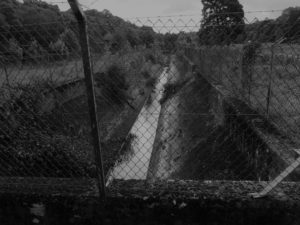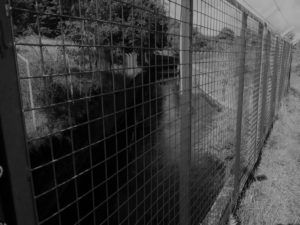From Unofficial Britain: Journeys Through Unexpected Places by Gareth E. Rees (Elliott & Thompson, 2020):
Some factories enter local lore in more subtle ways, especially when they are shrouded in mystery and rumour. In 1966, Bobby Seal, an eleven-year-old boy from Mold, went walking with his friends in the Rhydymwyn Valley in Flintshire, North Wales. Usually they’d stop by the river to try to catch fish with their bare hands, but on this day, they felt adventurous and followed the river upstream into unfamiliar territory. Sunlight flickered through gaps in the treetop canopy as the boys pushed further up the valley, which began to narrow and darken as its sides rose ever more steeply. Bobby tells the story:
The grass underfoot was lush and untrodden, suggesting that few others ever walked this way. We all felt uneasy, though none of us would admit it. We laughed and joked trying to lighten the oppressive mood, but soon we fell silent. Even the birds had ceased their singing. As we rounded a bend in the river, we beheld the massive rampart of what appeared to be an ancient fortress: a high concrete wall spanning the narrow neck of the valley, crested with metal railings and barbed wire. We edged closer, wary of our proximity to the river, which was now a narrow concrete channel, dark and forbodeing. However, the path came to an end and we were unable to proceed any further. Not wishing to linger in this gloomy spot, we retraced our steps and re-emerged into the world of light.
Several days later I told my dad about our walk and asked him if he knew anything about the strange dam up the valley. He told me that we’d clearly walked a long way and that the dam was part of the perimeter of an old factory. The factory was dangerous, he told me, and we should keep well clear of it.
My friends and I did keep away. But that wasn’t quite the end of it. Through my childhood I picked up snippets of talk from adult conversations referencing the ‘bomb factory’.
Bobby discovered as an adult that during the Second World War ICI ran a chemical weapons research facility known first as the X-Site and then the Valley Works. It was one of a series of secret and carefully protected factories used to manufacture and store mustard gas, despite its use being banned under the Geneva Protocol.


The Rhydymwyn Valley was ideal for such a facility because of its steep sides and dense woodland, which concealed the factory from enemy bombers, and its natural limestone tunnels, which could be used to keep the chemicals safe. Bobby also told me:
The factory was involved in some of the early gas diffusion experiments that formed the basis for the Manhattan Project – the Allied nuclear bomb. Later it played an important role in similar experiments which led to the development of a British nuclear weapon.
Because of the extreme sensitivity of its operations, the factory’s existence was kept hush-hush, existing only in fragments of adult chatter that Bobby heard as a youngster. There was much speculation about how else the valley’s limestone tunnels were used after the war, but the only confirmed function was to house strategic food stores during the 1950s and 1960s for use in national emergency. Even today, says Bobby, officials are cagey about allowing access to the now derelict site, which is fenced off and patrolled by guards. Sentry boxes line the old rails that used to carry materials between its various flat-roofed buildings, spaced out so that if one exploded, there would not be a chain reaction. These are now empty. Their loading platforms overgrown. Paintwork peeling. Flanked by signs reading: ‘DANGER: Keep Out’. Derelict or not, it seemed there will still things inside this place that needed to be kept out of the public eye.
In 2015 Bobby gained permission to explore the bomb factory, so long as he was accompanied by a guide. As he reached the southern end of the site, the valley began to close in on him. The light dimmed and it grew cold, evoking a sensation that he’d not felt since his boyhood adventure in 1966.
 At a corner of fencing, he looked through the slats to see a steep drop to the valley below. He was standing on the top of the concrete dam: the same fortress in the woods that he had gazed up at as an eleven-year-old. Water trickled down the wall and pooled in a narrow channel far below. And there, at the foot of the structure that had haunted his memories for almost half a century, he thought he could see four young boys gawping up at him, silent and wide-eyed.
At a corner of fencing, he looked through the slats to see a steep drop to the valley below. He was standing on the top of the concrete dam: the same fortress in the woods that he had gazed up at as an eleven-year-old. Water trickled down the wall and pooled in a narrow channel far below. And there, at the foot of the structure that had haunted his memories for almost half a century, he thought he could see four young boys gawping up at him, silent and wide-eyed.

Oh goodness, how did I not spot this when I read the book??!
Yes, it was lovely to meet up with Gareth and go for a walk and a chin wag together!
Background for Psychogeography ?
https://twitter.com/i/status/1688471996244361216